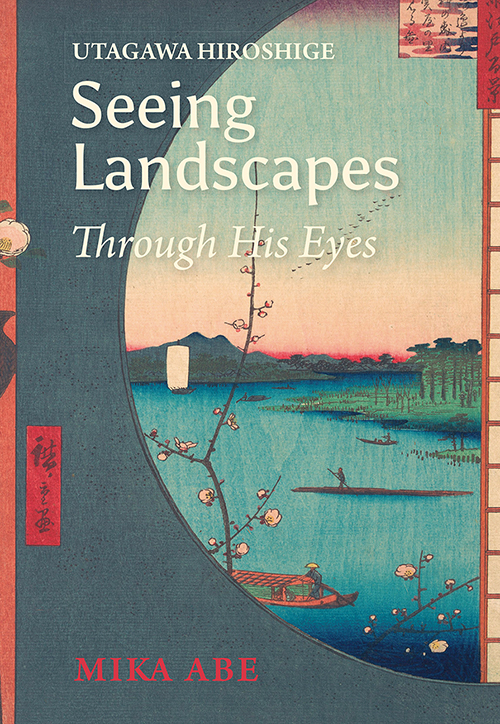Home > Book Detail Page

In the late Edo period, when society was maturing and Japan was moving to open its doors to the outside world, landscapes were undergoing major changes. Many world-famous ukiyo-e painters were active during this period, among them Utagawa Hiroshige. Hiroshige le us not only his ukiyo-e paintings but also his words. is book explores Hiroshige’s views of the landscape through his ukiyo-e work Ehon Edo Miyage (Edo Souvenirs), published from 1850 to 1867, while placing considerable emphasis on the analysis of Hiroshige’s text, which is o en neglected by art historians.
Why did Hiroshige depict ordinary scenes featuring common people, not only famous tourist places, in his ukiyo-e?
What was it that Hiroshige wanted to convey through his picture book?
His work explores not only the bright life of Edo, but also the reality of the surrounding scenery, which was rapidly transforming in the midst of social change. This book allows us to see the landscape of the time through Hiroshige’s eyes and to experience his connection to scenery.
Why did Hiroshige depict ordinary scenes featuring common people, not only famous tourist places, in his ukiyo-e?
What was it that Hiroshige wanted to convey through his picture book?
His work explores not only the bright life of Edo, but also the reality of the surrounding scenery, which was rapidly transforming in the midst of social change. This book allows us to see the landscape of the time through Hiroshige’s eyes and to experience his connection to scenery.
Author
Mika Abe, PhD, holds a JSPS Research Fellowship for Young Scientists at Kyoto Prefectural University. She was born in Milan, Italy. Aft er completing the doctoral program at the Graduate School of Human and Environmental Studies, Kyoto University, she was a visiting scholar at the University of Leicester, UK, worked as an associate professor at Senshū University in Japan, and then became a part-time lecturer at Doshisha University, and later a researcher at Kyoto University. She specializes in historical/cultural geography and landscape theory.
Translation Editor
Sam Bamkin is based at the University of Tokyo Graduate School of Education and Institute for Advanced Studies on Asia. He leads scholarly research in Japanese and comparative education, policymaking and ethics; writes on Japanese society and intercultural communication; and promotes intellectual exchange between Japan and the UK.
Mika Abe, PhD, holds a JSPS Research Fellowship for Young Scientists at Kyoto Prefectural University. She was born in Milan, Italy. Aft er completing the doctoral program at the Graduate School of Human and Environmental Studies, Kyoto University, she was a visiting scholar at the University of Leicester, UK, worked as an associate professor at Senshū University in Japan, and then became a part-time lecturer at Doshisha University, and later a researcher at Kyoto University. She specializes in historical/cultural geography and landscape theory.
Translation Editor
Sam Bamkin is based at the University of Tokyo Graduate School of Education and Institute for Advanced Studies on Asia. He leads scholarly research in Japanese and comparative education, policymaking and ethics; writes on Japanese society and intercultural communication; and promotes intellectual exchange between Japan and the UK.
List of Figures
List of Tables
Preface and Acknowledgements
Introduction
Part I: The Metropolis and the Artist
1 Hiroshige’s Edo: An Unprecedented Metropolis
2 Ukiyo-e Prints: A Popular Amusement in the “Floating World”
3 Hiroshige the Artist
Part II: Exploring Hiroshige’s Landscape Perspective Through His Words
4 An Analytical View of Ehon Edo Miyage
5 Ehon Edo Miyage: Genre, Content and Composition
6 “Fūkei” by Hiroshige and How Its Synonyms Are Used
7 Hiroshige’s Landscape Perspective Expressed in Written Form in Ehon Edo Miyage
8 Farmland and Countryside in Ehon Edo Miyage
Part III: Seeing Through Hiroshige’s Eyes
9 Hiroshige’s Landscape Perspective: Combining His Words and Pictures
10 Rereading a Masterpiece: Hiroshige’s Thoughts in Meisho Edo Hyakkei
Epilogue
Appendix 1
Appendix 2
Appendix 3
Index
List of Tables
Preface and Acknowledgements
Introduction
Part I: The Metropolis and the Artist
1 Hiroshige’s Edo: An Unprecedented Metropolis
2 Ukiyo-e Prints: A Popular Amusement in the “Floating World”
3 Hiroshige the Artist
Part II: Exploring Hiroshige’s Landscape Perspective Through His Words
4 An Analytical View of Ehon Edo Miyage
5 Ehon Edo Miyage: Genre, Content and Composition
6 “Fūkei” by Hiroshige and How Its Synonyms Are Used
7 Hiroshige’s Landscape Perspective Expressed in Written Form in Ehon Edo Miyage
8 Farmland and Countryside in Ehon Edo Miyage
Part III: Seeing Through Hiroshige’s Eyes
9 Hiroshige’s Landscape Perspective: Combining His Words and Pictures
10 Rereading a Masterpiece: Hiroshige’s Thoughts in Meisho Edo Hyakkei
Epilogue
Appendix 1
Appendix 2
Appendix 3
Index











